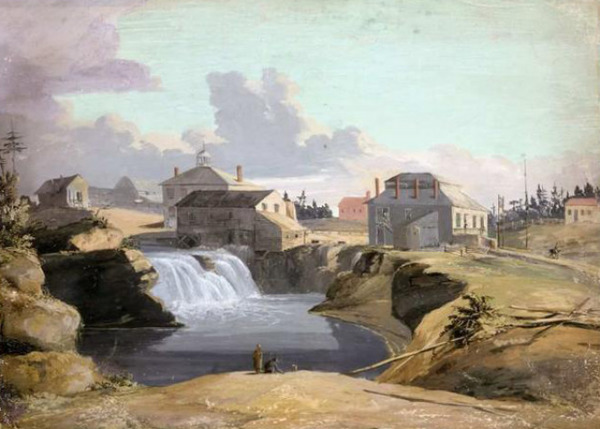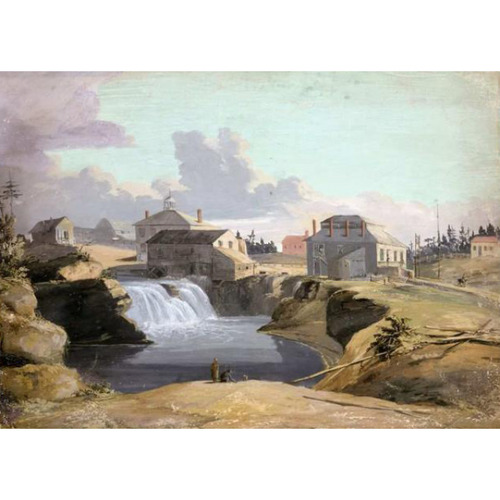
Source: Link
DuVERNET, HENRY ABRAHAM (in 1842 he changed his name to Henry Abraham DuVernet Grosset Muirhead), army officer, military engineer, and jp; b. 4 April 1787, eldest of ten children of Abraham DuVernet and Miriam Grosset Muirhead; m. Martha Maria Iqualin Van Kemper, and they had three children; d. 16 Dec. 1843 at Bredisholm, his residence near Coatbridge, Scotland.
Henry Abraham DuVernet’s family traced its origins in France back to 1150. After the Reformation one branch remained in France and the other, Huguenot, went first to the Low Countries and then to England. DuVernet’s father, a colonel in the Royal Artillery, was an aide-de-camp to Prince William Henry. Following Abraham DuVernet’s accidental death in 1806, the prince befriended his widow and obtained commissions for some of his sons.
DuVernet himself had been appointed ensign in the Royal Staff Corps on 22 Dec. 1803 and was promoted lieutenant on 12 Sept. 1805. His first active service was with Major-General Brent Spencer’s expedition to the Mediterranean in 1808. He subsequently took part in the retreat to La Coruña, Spain, with Lieutenant-General Sir John Moore and was invalided home in 1809. DuVernet was made captain on 30 May of that year, major on 2 June 1825, and lieutenant-colonel on 31 Dec. 1828. Placed on half pay on 1 July 1834, he was then the longest serving officer in the Royal Staff Corps (over 30 years); he became colonel in 1840.
In 1818 the Duke of Richmond [Lennox*], governor-in-chief of British North America, submitted a masterly report on the defences of the colonies. He stressed the urgent need for an alternative route between Montreal and Kingston to obviate the possibility of supply convoys of canoes and bateaux being ambushed in the upper St Lawrence River should hostilities with the United States break out again. DuVernet was sent to the Canadas with two companies of the Royal Staff Corps to take over the project. He arrived at Quebec on 29 July 1819.
The alternative route involved the construction of three small canals around rapids in the Ottawa River, opposite present-day Hawkesbury (Ont.), and the canalization of the Rideau and Cataraqui rivers through the Rideau lakes. The Rideau Canal would be built later by John By of the Royal Engineers; the Ottawa River canals were DuVernet’s responsibility. Arriving at the site late in the summer of 1819, he expected to receive detailed instructions from Richmond, who was on a tour of inspection which was to end at the Ottawa. Unfortunately, Richmond died before reaching the river, so DuVernet had to proceed with a minimum of instructions. And until 1827 he was held to an annual expenditure of £8,000, which he only once exceeded.
Despite these limitations DuVernet soon showed himself to be an able engineer and administrator. The Grenville Canal was well advanced when, in 1826, the Duke of Wellington ordered a speeding up of this work and the building of the other canals, at Carillon and Chute-à-Blondeau. DuVernet returned from a long leave in England in July 1827 and remained in charge of the works until November 1833, when they were substantially complete. His design for the Carillon Canal provided a remarkable response to the problems posed by high land and excavation through solid rock. An entrance lock raised vessels 13 feet into a channel excavated with less difficulty farther inland and two locks at the other end brought the vessels down 23 feet to the river level. The Ottawa River canals remained in use until 1962 when they were submerged beneath the river, impounded by the Carillon Dam of Hydro-Québec.
DuVernet’s official correspondence reveals him to have been an engineer greatly respected by his superiors and always solicitous of his men. He was appointed justice of the peace for the district of Montreal in 1821. During the winter months he and his wife resided in Montreal or Chambly, but while construction was in progress they camped on the site, providing welcome hospitality to such travellers on the Ottawa as Nicholas Garry*. Like numerous military officers, DuVernet was also an artist, but only one of his paintings, a fine view of the mill and tavern of Philemon Wright at Chaudière Falls, has been found.
DuVernet returned to Great Britain after November 1833. Some time in 1842, after his mother’s death, he changed his name and inherited the Muirhead family estate, Bredisholm. He died there in 1843.
Henry Abraham DuVernet’s painting, Mill and tavern of Philemon Wright at the Chaudière Falls, Hull, 1823, is at the PAC.
PAC, MG 24, F29; RG 68, General index, 1651–1841. Private arch., Florence DuVernet (Ottawa), Genealogical information. Nicholas Garry, “Diary of Nicholas Garry, deputy-governor of the Hudson’s Bay Company from 1822–1835: a detailed narrative of his travels in the northwest territories of British North America in 1821 . . . ,” ed. F. N. A. Garry, RSC Trans., 2nd ser.6 (1900), sect.ii: 73–204. Burke’s landed gentry (1879). G.B., WO, Army list, 1810. Hart’s army list, 1840–41. R. [F.] Legget, Ottawa waterway: gateway to a continent (Toronto and Buffalo, N.Y., 1975).
Cite This Article
Robert F. Legget, “DuVERNET, HENRY ABRAHAM (Henry Abraham DuVernet Grosset Muirhead),” in Dictionary of Canadian Biography, vol. 7, University of Toronto/Université Laval, 2003–, accessed January 20, 2026, https://www.biographi.ca/en/bio/duvernet_henry_abraham_7E.html.
The citation above shows the format for footnotes and endnotes according to the Chicago manual of style (16th edition). Information to be used in other citation formats:
| Permalink: | https://www.biographi.ca/en/bio/duvernet_henry_abraham_7E.html |
| Author of Article: | Robert F. Legget |
| Title of Article: | DuVERNET, HENRY ABRAHAM (Henry Abraham DuVernet Grosset Muirhead) |
| Publication Name: | Dictionary of Canadian Biography, vol. 7 |
| Publisher: | University of Toronto/Université Laval |
| Year of publication: | 1988 |
| Year of revision: | 1988 |
| Access Date: | January 20, 2026 |



